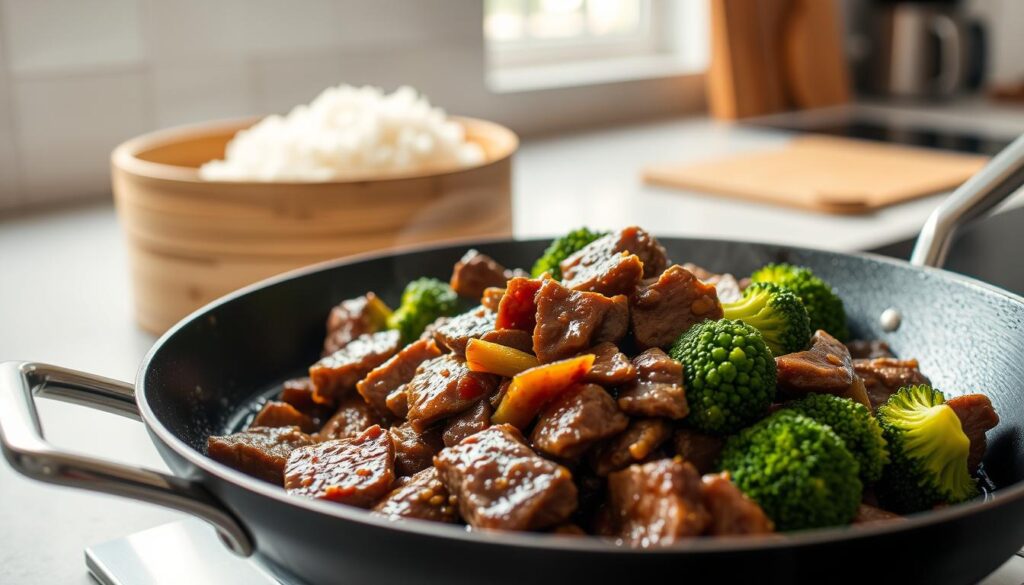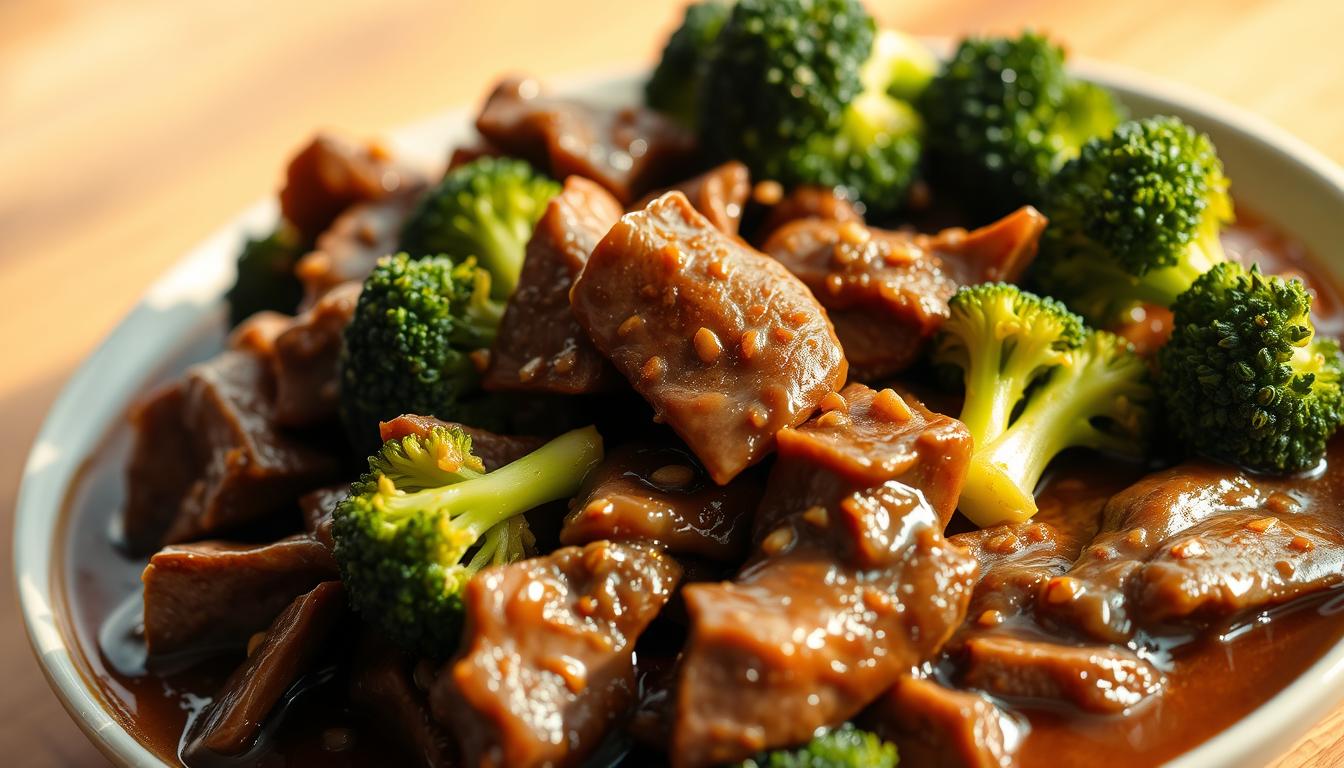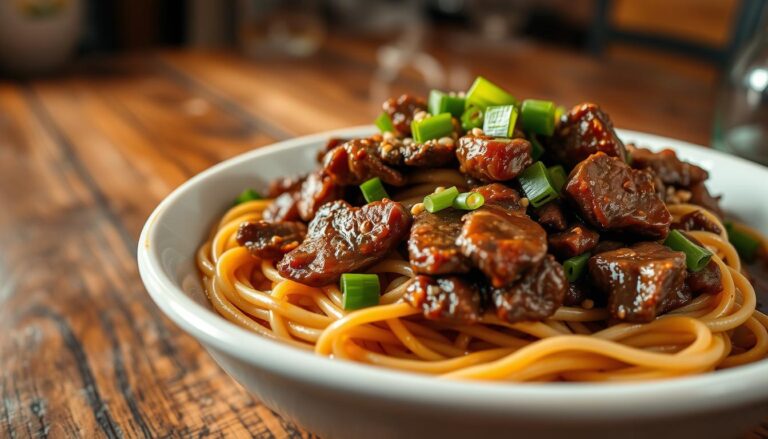Quick & Delicious Chinese Beef and Broccoli Recipe
Craving takeout flavors but short on time? This restaurant-style beef and broccoli brings the bold taste of your favorite Chinese dish to your kitchen in under 30 minutes. Best of all, you don’t need a wok—just a trusty skillet and everyday ingredients.
The secret lies in high-heat cooking and a savory sauce made with soy, fresh ginger, and garlic. Tender strips of beef sear quickly, while broccoli stays crisp-tender for that perfect texture contrast. Plus, everything cooks in one pan, making cleanup a breeze.
You’ll master the stir-fry technique that locks in flavor without overcooking the ingredients. We’ll also share tips for adjusting the sauce’s thickness and spice level to match your preferences. Whether it’s a busy weeknight or a cozy dinner, this recipe delivers every time.
Key Takeaways
- One-pan meal ready in under 30 minutes
- Uses standard kitchen tools (no wok required)
- Features a rich sauce with soy, ginger, and garlic
- Combines tender beef with crisp broccoli
- Includes pro tips for perfect stir-fry results
Overview of the Quick & Delicious Chinese Beef and Broccoli Recipe
This iconic stir-fry has become a staple in American-Chinese cuisine, evolving from Cantonese traditions to takeout menus nationwide. Its enduring popularity comes from balanced textures and savory flavors that adapt beautifully to home kitchens.
Introduction to a Classic Dish
Born in Chinese-American restaurants during the 20th century, beef and broccoli became a lunch-counter favorite for its quick cooking time and nutrient-packed ingredients. Unlike deep-fried takeout options, this version uses minimal oil while delivering bold umami flavors through its signature sauce.
Why This Recipe Stands Out
Three elements make this dish exceptional:
- Restaurant-quality sauce: A blend of soy sauce, fresh garlic, and ginger creates depth without overpowering the beef
- Smart techniques: High-heat searing locks in juices while keeping broccoli crisp
- Adaptable format: Works with flank steak, sirloin, or even chicken if preferred
You’ll appreciate how the 30-minute timeline fits busy schedules. No special equipment needed—just a standard pan and basic kitchen tools. Later sections will show you how to adjust spice levels and pair it with steamed rice for a complete meal.
Must-Have Ingredients and Equipment
The foundation of every great stir-fry lies in smart ingredient selection and efficient tools. You’ll need 1 pound of thinly sliced beef (flank or sirloin work best), fresh broccoli florets, and these pantry staples: soy sauce, cornstarch, and sesame oil. Aromatics like minced garlic and grated ginger elevate the dish, while a simple sauce mixture ties everything together.
Your kitchen setup matters. A deep nonstick skillet outperforms traditional woks for home cooks—its flat surface ensures even cooking and contains splatters. Keep measuring cups and bowls handy for precise sauce ratios. Cornstarch does double duty: it tenderizes the beef during marinating and thickens the glaze later.
Prep smarter, not harder. Slice vegetables first, then mix sauces in separate bowls before heating your pan. This “mise en place” approach prevents overcooking when you’re juggling multiple components. For dietary swaps, use tamari instead of soy sauce or olive oil if sesame oil isn’t available.
Don’t underestimate sesame oil’s role—just a teaspoon added at the end enhances flavor dramatically. With everything prepped and measured, you’ll spend less time stirring and more enjoying your creation.
Prepping Your Beef and Broccoli
The key to tender beef and crisp broccoli lies in preparation. Start with flank steak—its tight muscle fibers soften beautifully when sliced against the grain. Cut ¼-inch strips at a 45-degree angle for maximum surface area. This creates melt-in-your-mouth bites that soak up the sauce.
For the broccoli florets, aim for uniform bite-sized pieces. Blanch them in boiling water for 60 seconds if you prefer softer stems. Pat everything dry—moisture is the enemy of proper searing. Mince 2-3 garlic cloves and grate a thumb-sized piece of fresh ginger to build aromatic depth.
Mix a quick marinade: 1 tbsp cornstarch, 1 tsp sugar, and 1 tbsp shaoxing wine. Toss the beef in this mixture—the cornstarch creates a protective crust during cooking. Keep ingredients set aside in separate bowls for smooth workflow.
When you add beef to the pan later, stir just enough to brown all sides without overcrowding. This technique prevents steaming and ensures caramelization. Your prep work now guarantees restaurant-quality textures in minutes.
Mastering the Marinade and Authentic Sauces
Transform ordinary beef into restaurant-worthy bites with a flavor-boosting marinade that does double duty. The secret lies in balancing salty soy sauce, sweet sugar, and nutty shaoxing wine—a trio that tenderizes while building complex umami depth.
For tougher cuts, add ¼ teaspoon baking soda to your marinade. This alkaline ingredient breaks down muscle fibers, creating melt-in-your-mouth texture in just 10-30 minutes. Fresh garlic and ginger infuse aromatic warmth without overpowering the meat.
Follow this formula for success:
- 1 tbsp soy sauce (salty base)
- 1 tsp sugar (caramelizes during cooking)
- 1 tbsp shaoxing wine (adds fermented richness)
- 1 tsp cornstarch (creates sauce-clinging coating)
Mix these with your sliced beef before heating the oil. The cornstarch not only tenderizes but also thickens your final sauce into a glossy glaze. Taste the mixture before adding meat—adjust sugar for sweetness or add chili flakes for heat.
Prep your aromatics and sauce components first. This mise en place approach ensures you’re ready to cook once marinating finishes. When you add beef to the pan later, that brief soak time pays off in juicy, flavor-packed results.
Master this step, and your serving will rival any takeout dish. The marinade’s precision directly impacts the sauce’s cling and sheen—keys to authentic texture in every bite.
chinese-beef-and-broccoli: Traditional Cooking Techniques
Unlock restaurant-quality results by harnessing high heat—the engine of authentic stir-fry. As food scientist Kenji López-Alt notes, “A screaming-hot pan creates the Maillard reaction that gives beef its signature char.” Preheat your skillet until water droplets sizzle and evaporate instantly.
Why choose a flat pan over a wok? Most home stoves lack the intense BTU output of commercial ranges. A heavy-bottomed skillet concentrates heat better, letting you achieve that crusty sear on beef while keeping broccoli bright green. Cook in batches—overcrowding drops the pan’s temperature fast.
Here’s the rhythm: Sear beef for 90 seconds per batch, then set aside. This prevents steaming and ensures caramelization. Return all meat to the pan for the final sauce toss. For broccoli, 2-3 minutes at max heat keeps stems crisp yet tender.
Watch the clock like a hawk. Overcook by 30 seconds, and your soy sauce-based glaze turns bitter. The ideal sauce clings to ingredients without pooling—achieved by mixing cornstarch with cold water before adding to the pan.
Your skillet becomes a flavor forge when managed correctly. Balance is key: glossy sauce coats each piece while allowing the dish to breathe. With these techniques, even weeknight dinners feel like takeout triumphs.
Ready to fire up the stove? The next section breaks down each step for flawless execution.
Step-by-Step Cooking Process
Fire up your skillet and let’s transform simple ingredients into a sizzling masterpiece. Heat 1 tbsp oil in your pan until shimmering—this takes about 90 seconds on medium-high. Add marinated flank steak in a single layer, resisting the urge to stir for 45 seconds. This creates the golden crust that defines great stir-fry.

Cook beef in two batches if your pan feels crowded. Remove seared meat once browned (1-2 minutes per batch) and set aside. Keep that heat cranked up—toss broccoli florets into the hot pan with a splash of water. Cover for 60 seconds to steam, then uncover to let moisture evaporate.
Push veggies to the pan’s edge. Add minced garlic and ginger to the center, letting them sizzle for 15 seconds until fragrant. Pour in your premixed sauce (soy, oyster sauce, cornstarch slurry) and watch it bubble into a glossy glaze.
Return all beef to the pan, tossing vigorously with broccoli and sauce for 30 seconds. The cornstarch activates fully here, coating every piece without becoming gummy. Remove from heat immediately—overcooking turns tender meat rubbery.
Timing is everything. From first sizzle to final toss, this recipe takes under 8 minutes. Serve your dish steaming hot over rice. Those crispy-edged steak slices and bright green broccoli prove you’ve nailed the technique.
Tips, Variations, and Ingredient Substitutions
Discover how simple changes can reinvent this classic dish every time you cook. Swap broccoli florets for snap peas or bell peppers—just keep veggie quantities to 1½ cups total. Gluten-free? Use tamari instead of soy sauce, and swap regular sugar with coconut palm sugar.
Transform tougher cuts like chuck steak into tender bites. Add ¼ tsp baking soda to your marinade and let flank steak sit for 15 minutes before cooking. This breaks down fibers without altering flavor.
Adjust your sauce like a pro:
- Spicy: Add 1 tsp chili oil to the sauce
- Sweet: Increase sugar to 2 tsp
- Nutty: Finish with ½ tsp sesame oil
No wok? No problem. A cast-iron skillet creates perfect sear on beef. For crisp-tender veggies, blanch carrots first if using. Double the garlic ginger mix if you love bold aromatics—up to 3 cloves works beautifully.
These tweaks maintain the dish’s soul while letting your taste buds lead. Try one swap weekly—soon you’ll have six new recipes in your rotation. Remember: Great cooking thrives on experimentation, not rigid rules.
Conclusion
Mastering restaurant-quality meals at home becomes effortless with this beef and broccoli recipe. By focusing on proper prep—slicing against the grain and quick marinating—you ensure tender meat every time. High-heat cooking locks in flavors while keeping veggies crisp.
The magic lies in balancing soy sauce’s saltiness with aromatic ginger and garlic. A standard skillet works perfectly for achieving that golden sear. Serve your creation over steamed rice for a complete meal that rivals takeout.
Adapt the dish to your taste: swap proteins, adjust spice levels, or try gluten-free soy alternatives. This versatile recipe proves weeknight dinners can be both speedy and spectacular.
Ready to impress your family? Whip up this sesame-kissed stir-fry and share your twist online. Once you nail the technique, you’ll crave homemade versions of other restaurant favorites too.
FAQ
Can I substitute soy sauce in this beef and broccoli recipe?
Yes! For a gluten-free option, use tamari or coconut aminos. Low-sodium soy sauce like Kikkoman works well if you prefer less salt. Adjust sugar in the sauce to balance flavors.
How long should I marinate the beef?
Marinate thinly sliced flank steak for 15–30 minutes. For deeper flavor, let it sit for up to 1 hour. Avoid over-marinating, as the cornstarch can break down the meat’s texture.
What’s the best cut of beef for this dish?
Flank steak is ideal for its tenderness and quick cooking time. Sirloin or skirt steak also work. Slice against the grain for maximum tenderness.
Can I use frozen broccoli instead of fresh?
Fresh broccoli florets are recommended for crispness. If using frozen, thaw and pat dry to avoid excess moisture. Add them later in cooking to prevent sogginess.
How do I store leftovers?
Store in an airtight container for up to 3 days. Reheat in a skillet or microwave. Add a splash of water or sesame oil to refresh the sauce.
Can I make this recipe without a wok?
Absolutely! Use a large skillet or cast-iron pan. Ensure high heat to replicate the wok’s searing effect. Stir constantly for even cooking.
Is there a substitute for Shaoxing wine?
Dry sherry or rice vinegar mixed with a pinch of sugar works. Skip it entirely if needed—the dish will still taste great with soy sauce and oyster sauce.







